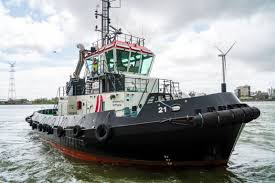
The world’s first methanol-powered tugboat highlights a greener future for shipping
ANTWERP : At first glance, there’s nothing to distinguish Tug 21 from any other working tugboat at the Port of Antwerp-Bruges in Belgium. With its bright red and white wheelhouse perched above a round black hull, it’s easily lost among the many tugboats guiding ships back and forth on the busy harbour. But take a look below deck and you’ll find the future of shipping.
Waterborne transport is vital to Europe’s economy. More than 75 % of Europe’s external trade and 35 % of the trade happening between EU Member States is transported by sea, river, canal or lake. This gives it a significant carbon footprint – the sector is responsible for 13.5 % of all transport-related greenhouse gas emissions in Europe, which is expected to increase as demand for shipping grows.
If Europe is to achieve its Green Deal goal of becoming the world’s first carbon-neutral continent by 2050, it must reduce waterborne transport’s environmental impact, while ensuring that such efforts support the growth of a modern and globally competitive shipping sector.
“We need to move away from fossil fuels, and everybody agrees on that,” says FASTWATER project coordinator Sebastian Verhelst, professor of Internal Combustion Engines at Ghent University in Belgium and Lund University in Sweden. “But if you look at shipping in general, it’s clear that electrification will be possible only for some niche applications.”
Liquid assets
The scale of the challenge is formidable. Worldwide shipping consumes around 200 million tonnes of fuel annually, comprising light and heavy fuel oils, diesel and liquified natural gas (LNG). Decarbonising the sector requires an equally abundant energy source. “We need vast amounts of fuel,” adds Verhelst, “and if you look at scalable renewable energy sources, that basically means wind and solar.”
Wind and solar power are cheap and plentiful. The electricity they generate can be used to bind water and CO2 from the air into methanol fuel, turning electrical energy into chemical energy.
Unlike hydrogen – also touted as a potential green fuel – methanol is liquid at ambient temperatures, making it suitable for smaller vessels that do not have space for high-pressure tanks or cryogenic storage. In addition, methanol is a common industrial feedstock, meaning that many port facilities already have the infrastructure necessary to move and store the fuel.
While ships powered by methanol have been around for nearly a decade, the technology was previously only workable on large ocean-going vessels. “There’s thousands and thousands of smaller vessels in European ports and around European coasts, and we didn’t have a solution for those, they needed a different engine technology,” explains Verhelst. The FASTWATER project set out to demonstrate the feasibility of methanol as a sustainable fuel for smaller vessels.
Clean solutions
The FASTWATER project focused on developing technical solutions to convert ship engines to run on methanol, building on previous work in Horizon projects LeanShips and HyMethShip. The result is Tug 21 – otherwise known as Methatug – the world’s first methanol-powered tugboat.
Driven by dual-fuel engines using conventional diesel as pilot fuel and running on up to 80 % methanol, the 30-metre-long vessel is powerful enough to tow 50 tonnes, and can store 12 000 litres of methanol in its hull, enough for 2 weeks of work.
Using renewably produced methanol, the redesigned vessel produces up to 80 % fewer greenhouse gas emissions than before, and 80 % less particulate pollution, making it better for the environment and for those living and working nearby. In addition, the chemistry of methanol means that sulphur oxide (SOx) and nitrogen oxide (NOx) emissions are significantly reduced.
In addition to Methatug, the FASTWATER project has also retrofitted a pilot boat in Sweden and a coastguard vessel in Greece, and developed a conversion concept for a methanol-powered river cruise ship in Germany. Following careful analysis of the performances of these ships, Verhelst and his colleagues plan to further develop their methanol solutions with a look towards commercialisation. “Our hope and expectation now are that smaller vessels can start operating on methanol,” notes Verhelst.
The project was coordinated by Lund University in Sweden, with support from the Port of Antwerp-Bruges, Ghent University, the Swedish Maritime Administration and specialist partners in Belgium, Germany, Greece, Sweden and the United Kingdom.
With transport by inland waterways and sea shipping expected to grow by 25 % by 2030, the sector’s carbon footprint will continue to grow without new technologies and regulations. Horizon projects such as FASTWATER are key not only for greening the fleets of individual ports, but as part of wider efforts towards EU goals of climate neutrality by 2050. By testing out innovative solutions for greening the shipping industry, we can reap positive rewards for the environment, for businesses and for citizens.
